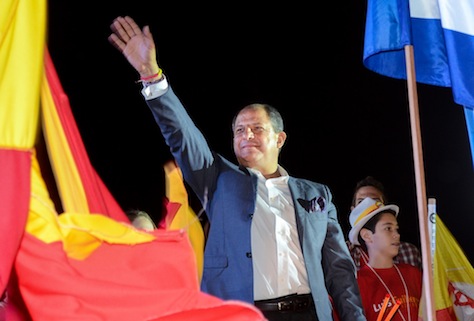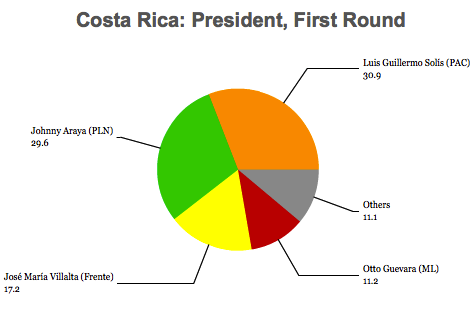He won the Costa Rican presidency yesterday with 78% of the vote. His opponent considered the runoff so hopeless that he conceded defeat and suspended his campaign a month ago. With nearly 1.3 million votes, he won more votes than any other Costa Rican presidential candidate in the country’s modern history.![]()
But now that he’s been officially elected Costa Rica’s new president, what will Luis Guillermo Solís (pictured above) do in office?
The first thing he’ll have to do is temper high expectations that Costa Rica’s first third-party president in modern history will suddenly transform the country into a wealthier, corruption-free, social democratic paradise.
The son of a cobbler and the grandson of a laborer on a banana plantation, Solís vowed to reverse the income and social inequality that’s become a growing concern in what is arguably Central America’s most politically and economically successful country.
Solís, a historian who has never held elective office, won a surprise victory won the first round of the presidential election on February 2, edging out one-time frontrunner Johnny Araya, the candidate of the ruling Partido Liberación Nacional (PLN, National Liberation Party) and the longtime mayor of San José. Solís’s strong showing against Araya in the final presidential debate bolstered his candidacy, which had languished in fourth or fifth place in polls, even a week before the February vote.
It was a magnificent turnaround for a candidate who barely figured in the polls at the end of 2013.
Solís won 77.85% in Sunday’s runoff, while 22.15% voted for Araya, despite the suspension of Araya’s campaign on March 6. He said that he’ll start announcing key members of his cabinet next Monday, April 14.
Araya was attempting to win a third consecutive presidential term for the PLN. In the 2010 vote, Costa Ricans elected Laura Chinchilla as the country’s first female president. Despite initially high expectations, Chinchilla’s administration has been a disaster, marred by embarrassing corruption scandals within the PLN and charges of lackluster economic policy.
Costa Rican voters also had doubts about Araya’s leading challenger, the far more leftist José María Villalta, the candidate of the socialist Frente Amplio (Broad Front), who had been expected to advance to a runoff against Araya.
So it’s not a surprise that voters would turn to Solís, who offered a slightly more leftist vision for Costa Rica than Araya and the PLN, but not so socialist as Villalta and the Broad Front.
He’ll take office with an incredibly fragmented Asamblea Legislativa (Legislative Assembly) — his own party, the Partido Acción Ciudadana (PAC, Citizen’s Action Party), holds just 13 seats in the 57-member chamber. That means he’ll have to form an alliance with the PLN, which holds 18 seats, or form ad-hoc coalitions with other lawmakers who range in ideology from Christian democratic to radical libertarian to chavista-style socialist.
It helps that Solís — and the PAC’s unofficial leader Ottón Solís (no relation to the president-elect) both started their political careers with the PLN. Ottón Solís, elected in February to the National Assembly as a deputy, will play an important role in forming and achieving the new administration’s agenda. For the past decade, opposition to the ruling PLN and to corruption has united the PAC, and it’s ideological diversity has been helpful in the 2014 campaign. Once in government, however, Luis Guillermo Solís may find it difficult to unite a party that contains both socialists and liberals — and to maintain a constructive role for Ottón Solís.
Though the clean sweep of a new administration after eight consecutive years of PLN rule will certainly reduce corruption, Solís hasn’t explained how he would eliminate the problem in the long term. While Solís is a critic of free-trade agreements, and he opposed the Central American Free Trade Agreement with the United States, and he’s pledged to increase education, welfare and health care spending and otherwise promote equality:
Solís said that his administration would focus on cleaning up corruption in the government to restore voter confidence, while getting the country’s public works infrastructure back up and running. He also wants to extend micro-credit to small and medium-sized businesses to tackle the country’s 18.6 percent unemployment rate, and get Costa Rica’s socialized health care system, the Caja, back on firm financial footing in 18 months. But before he can do that he’ll have to climb the polls, where he has stalled at around 4 percent, according to the latest figures.
But with Costa Rica expected to begin accession talks with the Organisation for Economic Co-operation and Development in 2015, Solís will come under pressure to reduce Latin America’s fastest-growing public debt and reduce a budget deficit that’s currently running at around 6% of GDP. Solís wants to reform Costa Rica’s universal health care system, the Caja Costarricense de Seguro Social, and one of Latin America’s most successful health-care programs, through fiscal savings — partly through a more transparent and centralized system of buying medicine.
Unlike Villarta, Solís shied away from embracing the socialist policies of the late Venezuelan president Hugo Chávez — already as president-elect, Solís is distancing himself from Nicaragua’s socialist president Daniel Ortega, partly due to a border dispute that’s strained Nicaragua relations with Costa Rica.
Luis Guillermo Solís’s victory marks a watershed triumph for the PAC, which was founded in 2000 by politicians from the two main leading parties at the time, the center-left PLN and the center-right Partido de Unidad Socialcristiana (PUSC, Social Christian Unity Party), with an emphasis on reducing corruption.
For the past three election cycles, the party’s founder Ottón Solís, a former economics minister in the 1980s during the first administration of Óscar Arias, has served as the PAC’s presidential candidate. Ottón Solís came closest to winning the presidency in 2006, when Árias narrowly won a second (non-consecutive) term to the Costa Rican presidency — Arias defeated Solís by just 1.1% in that election, and he avoided a runoff by just 0.9%.
Like Ottón Solís, Luis Guillermo Solís got his start in Costa Rican politics working alongside Árias — on the Esquipulas Peace Agreement that brought regional peace to war-weary Central America in the early 1990s,. He otherwise served as a top advisor to Árias and the PLN on foreign relations, and even briefly served as the PLN’s general secretary. He broke from the party in 2005 out of disgust for its corruption and other irregularities within the PLN’s internal elections.
Meanwhile, the PUSC brand is even more toxic, decimated by corruption scandals that have reduced it nearly to extinction. Rafael Ángel Calderón, Costa Rica’s president between 1990 and 1994, and. Miguel Ángel Rodríguez, Costa Rica’s president between 1998 and 2002, were both sentenced to prison on corruption charges. The PUSC’s initial 2014 presidential candidate, Rodolfo Hernández Gómez, withdrew in October 2013, capping a decade of electoral disasters. In the past three presidential elections, PUSC candidates have won between 3% and 6% of the vote.
Photo credit to Alberto Font/The Tico Times.


Previously, plagiarised content often ranked higher than the original piece.
Who would not want to become rich these days without exerting too much effort.
Off page SEO services
provide external support to a website by providing links from various leading websites.